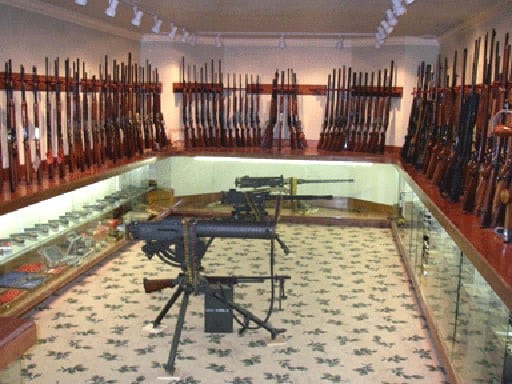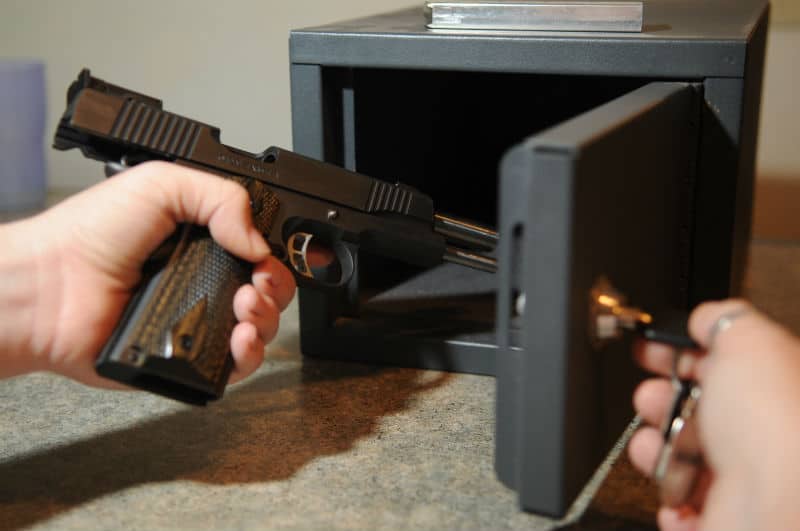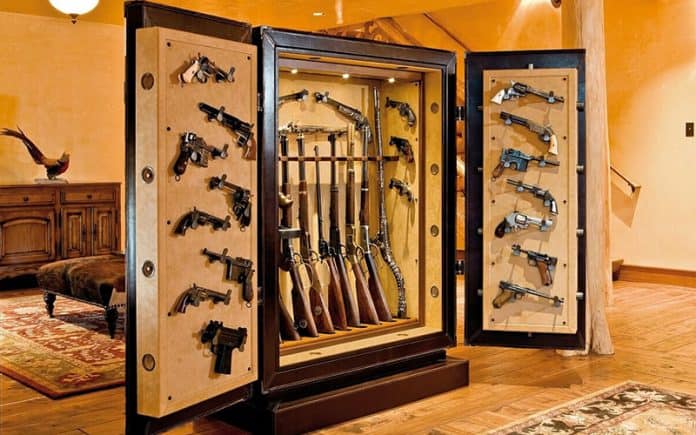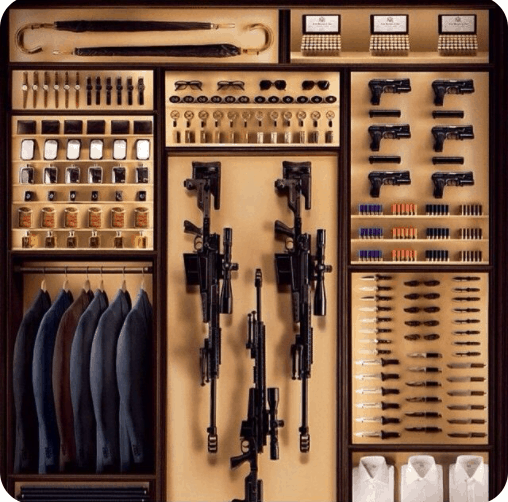Whether a hunter, competition shooter, or casual collector, almost every gun owner is well aware of the importance associated with protecting their firearms against threats of theft. After all, the purchase of a firearm is an investment, and such an investment should be protected by whatever means necessary.
This very thought compels many gun owners to purchase a gun safe, in a bid to safeguard their collection. However, those who own a significant number of firearms, are often left scrambling to find a safe large enough to meet their needs.
This can present quite the problem, as purchasing multiple gun safes is largely impractical, while storing such guns unprotected is no better solution.
As of late, a new trend in firearm storage and protection has emerged. Numerous gun owners have begun converting spare closets within their houses, into a fully operable gun and ammo safes of one configuration or another.
Doing so provides a significant amount of storage space to work with, and is far less difficult of a project to undertake than many might think.
The following guide will explain how to repurpose your own closet into a large-scale gun safe.
Table Of Contents
Making A Plan

Prior to beginning your project, it is extremely important to plan for that which lies ahead. This involves taking stock of the closet space that is to be converted and deciding the extent to which this space needs to be modified in order to meet your specific needs.
First, you must determine how secure you intend for your makeshift closet gun safe to be. This directly dictates the extensiveness of any modifications that will be necessary.
If you simply wish to construct a safe space to store your guns, where they cannot be easily accessed by children, then such a conversion will be rather simple to complete. However, if you are hoping to make your closet into a theft-proof fortress, a significant amount of revision will be needed.
You should also carefully consider the approximate number of firearms that you intend to store in your newly converted closet. This will weigh into the need for shelving/racks, as well as issues regarding the overall layout of your closet gun safe.
How To Complete Your Closet Conversion

Because every closet is different, no two gun safe conversions are the same. Therefore, the details surrounding such a project will vary from one application to the next.
However, the following are several key points that should be addressed when tackling a chore of this type.
Selecting A Door
One of the most important aspects of converting any closet into a gun safe relates to securing the closet safe’s door. Most standard closet doors are relatively light in build and can be easily breached with little effort.
In fact, many of these doors do not feature locking mechanisms of any type. As a result, a door of this style is best replaced with a more robust alternative.
Those wishing to convert their gun closet space into a gun safe choose to install a heavier steel door, such as those featured at the exterior points of access throughout the house. Doors of this configuration typically feature deadbolt or keypad style locks, which are far more secure than the standard door knob type locking mechanisms found on most wood doors.
To maximize the security of any metal door, a door frame of an equally hearty material should also be installed. Though replacing a closet’s pre-existing door frame can be a somewhat tedious chore, doing so makes it much more difficult for a burglar to gain entry to your makeshift gun vault during a break in.
Structural Reinforcement
Even with a heavier door in place, a typical walk-in closet can still be easily broken into through any adjoining wall. In the vast majority of cases, the only way to circumvent such issues is by reinforcing a closet’s interior walls.
However, doing so often involves a fair amount of work on a homeowner’s behalf.
One popular way of preventing alternate access to a safe room is by securing rebar or heavier layers of solid wood between the studs found in each perimeter wall. While this often involves the removal of existing drywall, there are few better ways to protect the contents of your makeshift gun room.
Reinforcing a closet’s walls prevents an intruder from bashing inward, with the use of a pick or crowbar. Under most circumstances, a thief will not pursue items that they cannot gain quick access to, for fear of lingering long enough to be caught in the act.
Fire Protection
Although theft is the primary concern of most gun owners, house fires can also put an individual’s gun collection at significant risk. Many of today’s premium gun vaults/safes are largely fireproof in nature.
Therefore, many who wish to convert their closets into high-security gun storage, also wish to achieve the same level of protection.
Fireproofing a gun room can be a rather tedious chore. However, make great strides in this direction by installing fire-resistant panels and flooring within the space in question.
Ceramic or stone tile can be used to line a closet safe’s floor, while specialty sheetrock with a designated fire rating can be used on each wall.
Special care should also be taken to use only non-flammable or flame-resistant sealants when finishing a safe room. Sealants of this type will not readily combust when exposed to a heat source.
Storage Considerations

There are many ways to store guns within a closet safe room, all of which hold their own specific value. Firearms can be stored on a custom-built gun rack, or situated within a sizable gun cabinet.
The particular manner in which one chooses to store their firearms often comes down to the circumstances at hand, and overall personal preference.
Handguns are easily stored within a rather small area, while long guns, such as rifles and shotguns, take up a considerably larger space. Therefore, it is important to consider the scope of your firearm collection, before making definite decisions regarding storage.
In much the same manner, firearm-related accessories can be stored on peg boards, or within filing cabinets. Storage of this type can be constructed however a homeowner sees fit and ensures that such items can be accessed at a moment’s notice.
Building From Scratch

Additional options exist for those who plan on including a closet-style safe when building a new house. This is due to the fact that this designated closet space can be customized, to better meet the needs of the situation at hand.
Unlike in the case of converting a closet into a gun safe, those designing a space of this nature when drawing up floor plans, are presented with a blank slate to work with.
Many who find themselves in a situation of this nature, often opt for a larger closet door opening, in which a traditional vault door can be mounted. Some homeowners even choose to utilize a hidden door, for access into their newly constructed safe room.
This often involves situating an entry door behind a bookcase or other large fixture.
One can even go a step further, and outfit their safe, as well as their entire house, with an alarm system. This serves as an additional layer of protection, over that offered by your newly constructed safe.
A Project That Pays
While converting a standard closet into a makeshift gun safe can indeed prove to be a rather sizable project, there is certainly merit in such an endeavor. Constructing your own safe room will not only protect your firearm collection but provide you with peace of mind in the process.
If you have a little extra closet space at your disposal, and a few free weekends in the foreseeable future, then there has never been a better time to convert one of your home’s closets into a vault-style closet gun safe.
